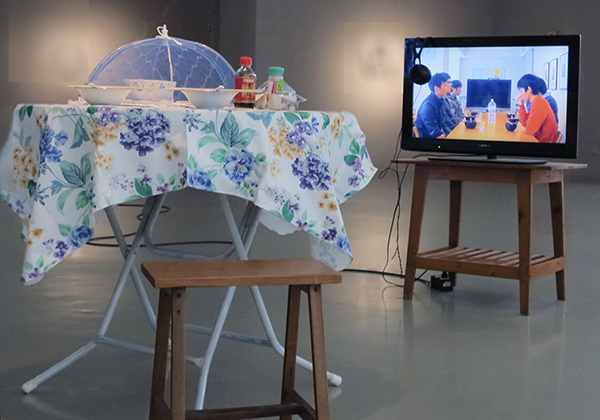Very Quiet, Please! โปรดเงียบอย่างมาก!
Video installation, one video channel with sound, a wall flat monitor with media box player, a dining Taiwanese set: a table, a chair, a set of a Taiwanese noodle bowl, a spoon, a pair of chop stick, a table mat, table cloth, a glass of water and a napkin. {Audio rate 44.1 kHz, Depth – 16 bit, Stereo, Color, 16:9}
วีดิโออินสตอเลชั่น วิดีโอหนึ่งช่องพร้อมเสียง 44.1กิโลเฮิร์ต ความลึก 16 บิต สเตอริโอ, สี, สัดส่วนภาพ 16:9, มอนิเตอร์จอแบน และ มีเดียเพลย์เยอร์, ชุดอุปกรณ์การทานอาหารแบบไต้หวัน ประกอบด้วย โต๊ะทานอาหารหนึ่งตัว, เก้าอี้หนึ่งตัว, ถ้วยก๋วยเตี๋ยว, ช้อน, ตะเกียบ, ที่รองจาน, ผ้าปูโต๊ะ, แก้วน้ำที่มีน้ำอยู่ข้างใน และผ้าเช็ดปาก.
Statement
โปรดเงียบอย่างมาก! เป็นงานที่ท้าทายพฤติกรรมการทานก๋วยเตี๋ยวของคนญี่ปุ่นซึ่งชื่นชอบการปลดปล่อยตนเองอย่างอิสระในขณะทานก๋วยเตี๋ยวโดยการการซดน้ำซุปจากชามและดูดเส้นก๋วยเตี๋ยวเข้าปากโดยไม่ต้องลดเสียงที่เกิดขึ้นจากกิจกรรมการกิน ซึ่งต่างจากพฤติกรรมโดยทั่วไปของคนญี่ปุ่นที่ส่วนใหญ่จะมีมารยาทที่เคร่งครัด เพื่อลดการกระทบกระทั่งในทุกๆเรื่องอย่างละเอียดลออ เสียงก็เป็นอีกเรื่องหนึ่งที่คนญี่ปุ่นมีความเคารพต่อผู้อื่นด้วยการที่ไม่เปิดเพลงเสียงดังในร้านค้า ในที่สาธารณะ ไม่คุยโทรศัพท์ในรถไฟ เป็นต้น
Very Quiet, Please! is a work that challenge Japanese noodle eating habit that appreciate to relieve themselves while eating. They take a sip of soup from bowl and suck up noodles into their mouth quickly without down the noise which occurs while eating. It is different from general behavior of Japanese that wary themselves by strict manners in order to carefully minimize the aggravation in every action. Sound is also one of the matters that Japanese respects other. They prefer to silence in public’s sphere. For example, they put down the volume of music in shop and public area and do not chat and turn sound off on a phone in public train or bus.
ฉันได้มีโอกาสไปเยี่ยมเมืองเล็กๆในหุบเขาอยู่ทางเหนือของโตเกียวกับเพื่อนคนญี่ปุ่น เราหยุดพักทานอาหารที่ร้านชำเล็กๆเพื่อทานอาหารกลางวัน ขณะที่ทานอาหารคุณป้าซึ่งคนทำอาหารและเจ้าของร้านหัวเราะเมื่อเห็นฉันทานอาหารอย่างเรียบร้อย เขาแนะนำว่าฉันควรทานแบบป่าเถื่อนตึงตัง (Eat wildly) กว่านี้มันถึงจะแสดงออกได้ว่าเราอยากทานและอาหารอร่อยมากเพียงใด ปรกติแล้วฉันมีพฤติกรรมการทานแบบคนญี่ปุ่นเมื่ออยู่ในประเทศญี่ปุ่น แต่บางครั้งก็ลืมตัวทานแบบที่ตนเองคุ้นเคย จึงทำให้คิดว่าหากคนญี่ปุ่นลองทานอาหารแบบที่เขาไม่คุ้นเคยบ้างจะเป็นอย่างไร
I had a chance to visit a small village in a valley where is in the north of Tokyo with Japanese friends. We stopped by a little shop for lunch. While we were eating, an auntie, who was a chef and shop owner, was laughing at me. She said I ate the food too gentle. She suggested me to eat wildly in order to express my desire to eat and how delicious the food is. Usually, I behave my eating like Japanese while I am in Japan, but sometimes I lose conscious and eat the way I habitually eat. From this event made me thinking to have Japanese eat noodle in the way they are not familiar with.
ฉันจึงได้เชิญศิลปินญี่ปุ่นที่ร่วมพำนักที่โตเกียววันเดอร์ไซต์อาโอยาม่า มาทานก๋วยเตี๋ยวไทยที่ฉันเป็นคนทำเอง เมื่อถึงเวลานัด ฉันเสิร์ฟก๋วยเตี๋ยวให้แขกทุกคน และเมื่อเริ่มทานไปได้สักพักฉันขอให้พวกเขาทานแบบไม่มีเสียงเลย ราวกับว่าถ้ามีคนแอบฟังเสียงเราโดยที่ไม่ได้มองเห็นเราเขาจะต้องไม่รู้ว่าพวกเรากำลังทานอาหารอยู่
I invited Japanese artists who are residence at Tokyo Wonder Site-Aoyama to eat noodle for lunch. I offered the noodle soup that I cooked myself. Once the lunch started, I served a bowl of noodles to every guest. After the lunch started for a while, I asked them to eat and move without making any noise. As if someone eavesdrops on without seeing us, they should not know we are eating noodles.
